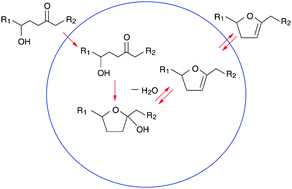There is growing awareness that heterogeneous reactions may be important in the atmospheric formation of secondary organic aerosols (SOA). Here, we report on the investigation of a series of recently identified heterogeneous reactions that convert 1,4-hydroxycarbonyls, a major product of alkane oxidation, to cyclic hemiacetals and then dihydrofurans in the particle-phase. Through these reactions, saturated 1,4-hydroxycarbonyls are converted to more reactive, unsaturated dihydrofurans, which can evaporate and react rapidly with atmospheric oxidants such as OH radicals, NO3 radicals, or O3. In order to investigate the conversion process quantitatively, a model was developed based on a proposed mechanism that includes gas-phase and heterogeneous reactions, as well as gas–particle partitioning. This model was used to simulate the time profiles of products formed from OH radical-initiated reactions of C11–C17 n-alkanes in the presence of NOx, for comparison with profiles of particle-phase cyclic hemiacetals measured during environmental chamber reactions of the same alkanes using a thermal desorption particle beam mass spectrometer. Results showed that the particle-phase isomerization of 1,4-hydroxycarbonyls to cyclic hemiacetals was fast in dry air, with a reactive uptake coefficient of at least 0.5. The lifetime for the subsequent particle-phase dehydration of cyclic hemiacetals to dihydrofurans was ∼15 min. The addition of water vapor (relative humidity ∼50%) slowed the conversion process, apparently by neutralizing adsorbed HNO3 that is thought to catalyze the reactions. Simulations performed with model parameters obtained from the experiments indicate that for typical atmospheric aerosol mass and oxidant concentrations and sufficiently acidic particles, 1,4-hydroxycarbonyls will be almost entirely converted to dihydrofurans in less than a day in both clean and polluted areas, whereas in the presence of neutralized particles the conversion may be minor. The outcome that occurs could have a significant impact on reaction products and SOA formation.


 Please wait while we load your content...
Please wait while we load your content...